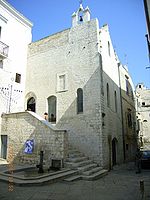
Scolanova Synagogue
Encyclopedia

is a synagogue
Synagogue
A synagogue is a Jewish house of prayer. This use of the Greek term synagogue originates in the Septuagint where it sometimes translates the Hebrew word for assembly, kahal...
in Trani
Trani
Trani is a seaport of Apulia, southern Italy, on the Adriatic Sea, in the new Province of Barletta-Andria-Trani , and 40 km by railway West-Northwest of Bari.- History :...
, Italy. It was built as a medieval synagogue, confiscated by the church during a wave of antisemitism around the year 1380, and converted for use as a church known as Santa Maria in Scolanova. In 2006, the building was de-sanctified by the Church and returned to its original use.
History
By 1380 all of the four synagogues in Trani had been converted to churches and the 310 Jews remaining in the city forcibly converted to Christianity. The four confiscated synagogues were renamed Santa Maria in Scolanova, San Leonardo Abate, San Pietro Martire, and Santi Quirico e Giovita (since renamed Sant'Anna, TraniSt. Anne's Church, Trani
St. Anne's Church located in Trani, Apulia in Italy, was built as the Scolagrande Synagogue during the medieval period; the structure houses now the Jewish Section of the Diocesan Museum of Trani.-History:...
), which was once the Scolagrande synagogue. San Pietro was later demolished. A plaque still visible on the northern wall of Sant'Anna explains that it was built on the site of a demolished synagogue in 1247. San Leonardo has undergone such extensive renovation that little of the synagogue building survives.
In 2006 the Scolanova Synagogue, which had been standing as an empty and disused church since the 1950s, was de-consecrated and returned to the Jewish community. The individuals principally responsible for the reconsecration of the synagogue were Professor and Mrs. Francesco Lotoro
Francesco Lotoro
Francesco Lotoro is an Italian pianist and musicologist.- Early career :After having studied at the Franz Liszt Academy of Music in Budapest, Francesco Lotoro became a specialized piano player, studying with Kornél Zempléni, Viktor Merzhanov, Tamás Vásáry and Aldo Ciccolini...
, Italian Anusim
Anusim
Anusim is a legal category of Jews in halakha who were forced or coerced to abandon Judaism against their will, typically while forcibly converted to another religion...
. Professor Lotoro is a pianist and conductor, who had studied the music of the Nazi concentration camps. The community now includes descendants of Neofiti
Neofiti
The neofiti were a group of Italian anusim, also known as crypto-Jews, living in Southern Italy.-History:The Jewish ancestors of the neofiti were forced to convert to Roman Catholicism in 1493. They continued to secretly practice certain elements of Judaism, however, as did many of their descendants...
(Italian crypto-Jews
Crypto-Judaism
Crypto-Judaism is the secret adherence to Judaism while publicly professing to be of another faith; practitioners are referred to as "crypto-Jews"...
) and San Nicandro Jews
Jews of San Nicandro
The Jews of San Nicandro are a small community of Jews from San Nicandro Garganico, Italy. All of the San Nicandro Jews are descended from local neofiti families from the 15th century...
.
A very old oil painting of St. Mary hangs in the niche that once held the torah ark. The Church has refused to allow the painting to be moved to another church or to a museum. Moreover, the building is a protected historic site, so the Jewish congregation is not allowed to move the painting. The solution has been to hang a large image of a menorah
Menorah
The menorah is described in the Bible as the seven-branched ancient lampstand made of gold and used in the portable sanctuary set up by Moses in the wilderness and later in the Temple in Jerusalem. Fresh olive oil of the purest quality was burned daily to light its lamps...
in front of the painting.
Architecture
The synagogue was converted for use as a church without significant alterations being made to the interior of the building. The Gothic synagogue is a rectangular, masonry building, 49 by 21 feet. The barrel-vaulted ceiling is 36 feet high. There are three windows in the eastern wall, one on each side of the Torah Ark, and one above it.The cut-stone surround for the Torah ark still exists. The ark was once reached by a flight of seven steps. It featured a central column that divided two separate arched openings.
The building next door once contained the synagogue's women's gallery and, in the basement, the stairs and pool of the medieval mikveh which survive.

